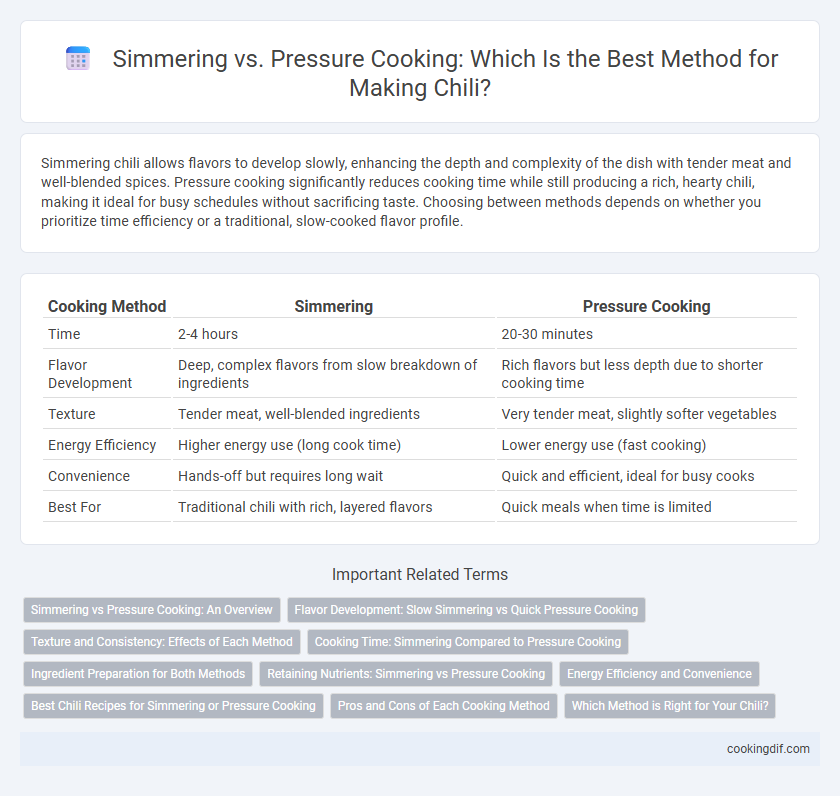Simmering chili allows flavors to develop slowly, enhancing the depth and complexity of the dish with tender meat and well-blended spices. Pressure cooking significantly reduces cooking time while still producing a rich, hearty chili, making it ideal for busy schedules without sacrificing taste. Choosing between methods depends on whether you prioritize time efficiency or a traditional, slow-cooked flavor profile.
Table of Comparison
| Cooking Method | Simmering | Pressure Cooking |
|---|---|---|
| Time | 2-4 hours | 20-30 minutes |
| Flavor Development | Deep, complex flavors from slow breakdown of ingredients | Rich flavors but less depth due to shorter cooking time |
| Texture | Tender meat, well-blended ingredients | Very tender meat, slightly softer vegetables |
| Energy Efficiency | Higher energy use (long cook time) | Lower energy use (fast cooking) |
| Convenience | Hands-off but requires long wait | Quick and efficient, ideal for busy cooks |
| Best For | Traditional chili with rich, layered flavors | Quick meals when time is limited |
Simmering vs Pressure Cooking: An Overview
Simmering chili involves cooking at low heat over a longer period, allowing flavors to meld and ingredients to tenderize slowly, which enhances the depth and richness of the dish. Pressure cooking significantly reduces cooking time by using high pressure and steam, producing tender beans and meat in a fraction of the time while retaining robust flavor. Both methods impact texture and complexity differently, with simmering favoring gradual flavor development and pressure cooking offering convenience and efficiency without sacrificing taste.
Flavor Development: Slow Simmering vs Quick Pressure Cooking
Slow simmering chili over low heat allows complex flavors to deepen and meld gradually, enhancing the richness and balance of spices, meat, and vegetables. Pressure cooking significantly reduces cooking time by using high steam pressure, but it can sometimes limit the full development of nuanced flavors compared to traditional simmering. Opting for simmering promotes a more robust and layered taste profile essential for authentic chili.
Texture and Consistency: Effects of Each Method
Simmering chili allows flavors to meld slowly, resulting in a rich, thick texture with tender meat and well-integrated ingredients. Pressure cooking drastically reduces cooking time while breaking down tough cuts, creating a softer texture but sometimes producing a thinner consistency due to rapid liquid release. Choosing between simmering and pressure cooking depends on desired chili thickness and tenderness, with simmering offering more control over texture and pressure cooking providing efficiency without sacrificing flavor depth.
Cooking Time: Simmering Compared to Pressure Cooking
Simmering chili typically requires 1.5 to 3 hours to fully develop deep, rich flavors and tenderize tougher cuts of meat. Pressure cooking drastically reduces cooking time to 20-30 minutes while achieving similar tenderness and flavor extraction by cooking under high steam pressure. Choosing between methods depends on available time, with pressure cooking offering a fast alternative and simmering providing gradual flavor layering.
Ingredient Preparation for Both Methods
Simmering chili requires chopping vegetables and browning meat to develop deep flavors, followed by slow cooking to meld ingredients gradually. Pressure cooking involves quick searing of meat and sauteing aromatics before sealing the pot, allowing ingredients to cook rapidly under high pressure while preserving texture and nutrients. Both methods benefit from seasoning early, but pressure cooking demands precise timing to avoid overcooking delicate components.
Retaining Nutrients: Simmering vs Pressure Cooking
Simmering chili allows gradual heat exposure, preserving heat-sensitive vitamins like vitamin C and some B vitamins more effectively than pressure cooking. Pressure cooking uses high temperature and steam, which can cause a slight loss of certain nutrients but retains minerals and enhances the bioavailability of others, such as iron and zinc. Choosing between simmering and pressure cooking depends on nutrient priorities and desired cooking time efficiency in chili preparation.
Energy Efficiency and Convenience
Simmering chili on low heat consumes more energy over a long period compared to pressure cooking, which significantly reduces cooking time and energy use by raising the boiling point through sealed high pressure. Pressure cooking preserves more flavors and nutrients due to shorter cooking times, making it a convenient option for busy households. However, simmering allows for gradual flavor development and greater control over texture, appealing to traditional chili enthusiasts despite its higher energy demand.
Best Chili Recipes for Simmering or Pressure Cooking
Simmering chili allows flavors to meld slowly, producing rich, deeply developed taste ideal for traditional recipes with beans and meat. Pressure cooking significantly reduces cooking time while tenderizing tough cuts of meat quickly, making it perfect for busy cooks seeking hearty chili without hours of simmering. For best results, recipes with robust spices and dense ingredients benefit from simmering, whereas soups and stews with chunkier vegetables excel in a pressure cooker.
Pros and Cons of Each Cooking Method
Simmering chili allows flavors to develop slowly, resulting in a rich, deeply integrated taste but requires longer cooking time and constant attention to prevent burning. Pressure cooking significantly reduces cooking time, tenderizing meat quickly and locking in moisture, but may risk overcooking or less nuanced flavor development compared to slow simmering. Choosing between methods depends on desired cooking duration, texture preference, and flavor complexity for the chili.
Which Method is Right for Your Chili?
Simmering chili allows flavors to meld slowly, producing a rich, deep taste ideal for complex recipes that benefit from long cooking times. Pressure cooking drastically reduces cooking time while tenderizing meat and infusing spices quickly, perfect for busy cooks seeking fast results without sacrificing flavor. Choosing the right method depends on your schedule and flavor intensity preferences, with simmering favored for traditional depth and pressure cooking for efficiency.
Simmering vs Pressure Cooking for chili method Infographic

 cookingdif.com
cookingdif.com